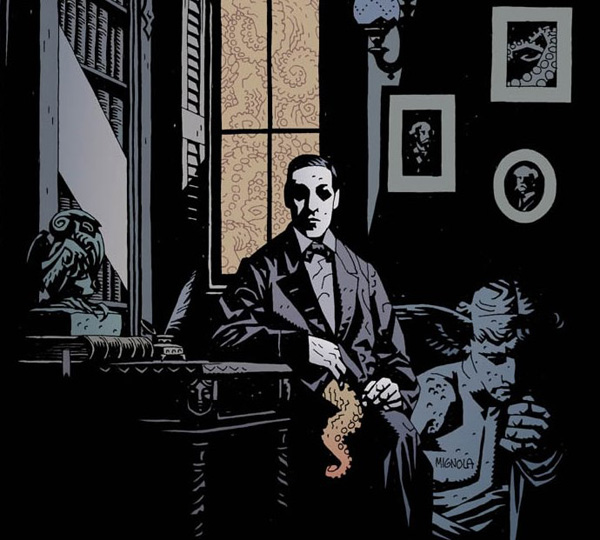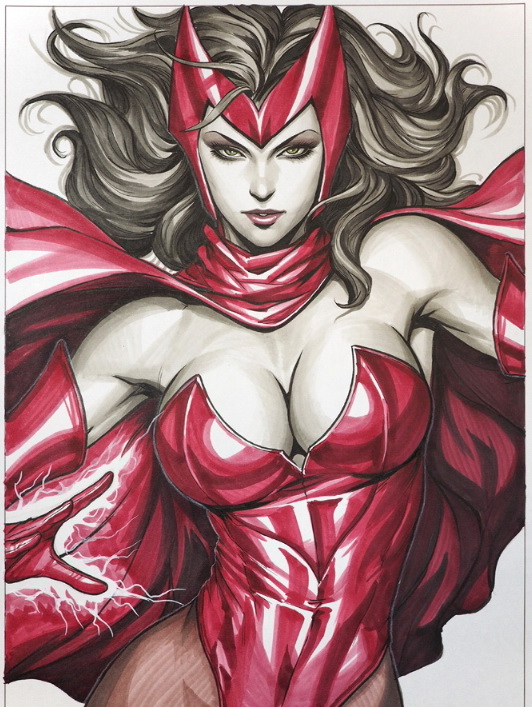Where Space Ends, Hell Begins…
“Lovecraft creates dark and sometimes horrific scenarios which, in their tense and gothic style, can seem like the visions of a madman. The formless entity dominates his work, an impalpable threat which lies beneath everything he wrote…” – The SF Source Book.
With Halloween just about a fortnight away, the focus shifts inevitably from SF to horror. One fine way to execute a clean transition between the two is to select one of the main masters of the macabre: Howard Phillips Lovecraft (1890-1937) who – through his twisted scribblings – managed to encompass both genres. Surely, you may think, his distorted visions were too dark and twisted to nestle satisfactorily within the boundaries of SF?
Nevertheless, there are good reasons for Lovecraft’s work to be included unquestionably into the realm of science fiction. Primarily, a considerable proportion of those “unspeakable entities” that languished amidst “his cluttered prose” were not so much demons but aliens. Moreover, he was one of the first authors to write and describe alien beings. Outside of the Cthulhu Mythos, he certainly wrote more genuine science fiction.
The most striking examples include: In the Walls Of Eryx, set on Venus, reimagined as a jungle planet; and tales of unorthodox scientific experiments: From Beyond (made into a movie in 1986) and Cool Air (which deserves big screen treatment). A significant proportion of his short stories were published in Weird Tales, a predominantly SF magazine of the 1920s and 30s; The Shadow Out Of Time was first published in the June 1936 issue of Astounding Stories, then the most prestigious science fiction magazine available.
Despite undesirable accusations of muddled prose and complicated storytelling, Lovecraft remains one of my favourite 20th century authors. Ironically, his complicated style is distinctive and had such a profound effect on me, helping to conjure some of my own fictional nightmares.
“[Universal] were blown away by the visual presentation, they openly admitted to loving the screenplay, saying it was dead on… I do not want ‘Mountains’ to be bloody, I do not want it to be crass, but I do want it to be as intense as possible” – Guillermo del Toro.
Guillermo del Toro is one of the most talented film-makers working today. It is no secret that, just a few years ago, the Spanish director should have made his own grandiose cinematic version of Lovecraft’s At The Mountains Of Madness.
In this novella (first published in 1931 and serialized in Astounding Stories in 1936), the geologist William Dyer – a professor from Miskatonic University – “writes to disclose hitherto unknown and closely kept secrets in the hope that he can deter a planned and much publicized scientific expedition to Antarctica.” Allegedly, his previous expedition unearthed “fantastic and horrific ruins (including strange fossils of unheard-of creatures and carved stones tens of millions of years old)” and “a dangerous secret of the City of the Old Ones that lay beyond a range of mountains taller than the Himalayas.”
Problem is, this encouraging project has been festering in development-hell for far too long. No matter how awesome his pre-production designs were – they invariably are – the prospect of a Producer tag for James Cameron and top-billing for Tom Cruise (?!) were too off-putting. Apparently he was just one week away from commencing production of At The Mountains in 2011 when Universal pulled the plug “due to budget issues.”
However, del Toro would not be perturbed for long; he resurrected his dormant plans for his Lovecraft project in 2013.
“I’m going to try it one more time,” he said in one recent interview. “Once more into the dark abyss. We’re going to do a big presentation of the project again… and see if any [studio’s] interested.”
(Unfortunately)… “Tom [Cruise] is still attached… He’s been such a great ally of the project.”
“In the coldest regions of space, the monstrous entities Ogdru Jahad – the Seven Gods of Chaos – slumber in their crystal prison, waiting to reclaim Earth… and burn the heavens” – De Vermis Mysteriis, Page 87.
A quick glance at modern strands of science fiction and horror – be it literature, movies or comics – it doesn’t take long to find the influence of the Cthulhu Mythos.
The most notable is the Hellboy comic, created by Mike Mignola in 1993. Developed into one of the stranger – and better – of the recent crop of comic book movies, directed by (what a surprise) Guillermo del Toro in 2004, the titular hell-spawned hero (played by the ever-reliable Ron Perlman) has to battle with not only Rasputin the “Mad Monk,” but the Ogdru Jahad, the most blatant nod to Lovecraft you’ll get in a mainstream comic book movie.
Lovecraft’s work may not seem best suited to the medium of comics, but in the ever-capable talented hands of the artistic genius: Berni(e) Wrightson, it works wonders. A number of Lovecraft’s stories were adapted brilliantly by Wrightson and published in Creepy Magazine during the ’70s.
In 1971, he did a splendid job on the aforementioned Cool Air, which came into my collection a decade later when Eclipse Comics compiled Wrightson’s best horror strips (in added colour!) in Berni Wrightson: Master Of The Macabre.
This – the third page – is a fine example of Wrightson’s style:
The seventh and final page is a creepy classic single splash and will be saved for a forthcoming Post!
Have just discovered this (below) online; how long will it take to track this particular issue down?

And, come on, if we’re going to end this Post with Hellboy gifs, might as well have the one with that dastardly mute puppet, the “freak in the gas mask”: Karl Ruprecht Kroenen (“Hitler’s top assassin and Head of the Nazi Cthulhu Society”) performing his ubercool blade-twirling trick inside Manhattan’s Metropolitan Art Museum.
“What horrible will could keep such a creature as this alive?” – Professor Trevor Broom.















